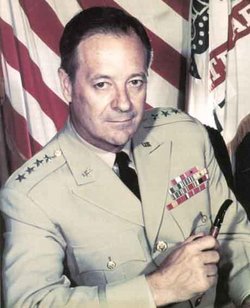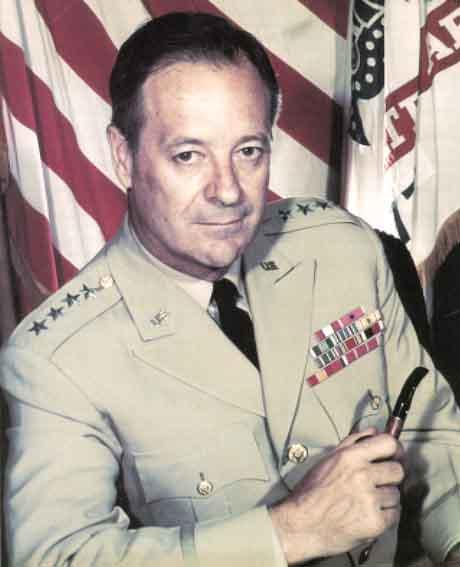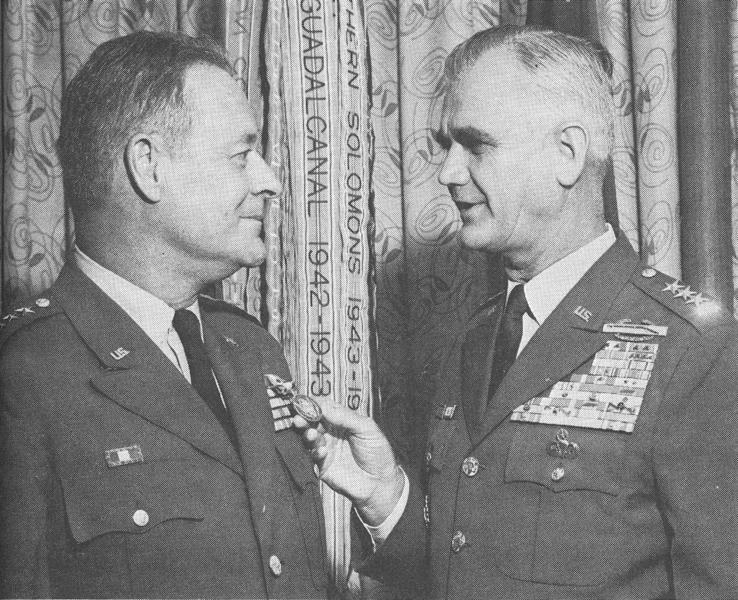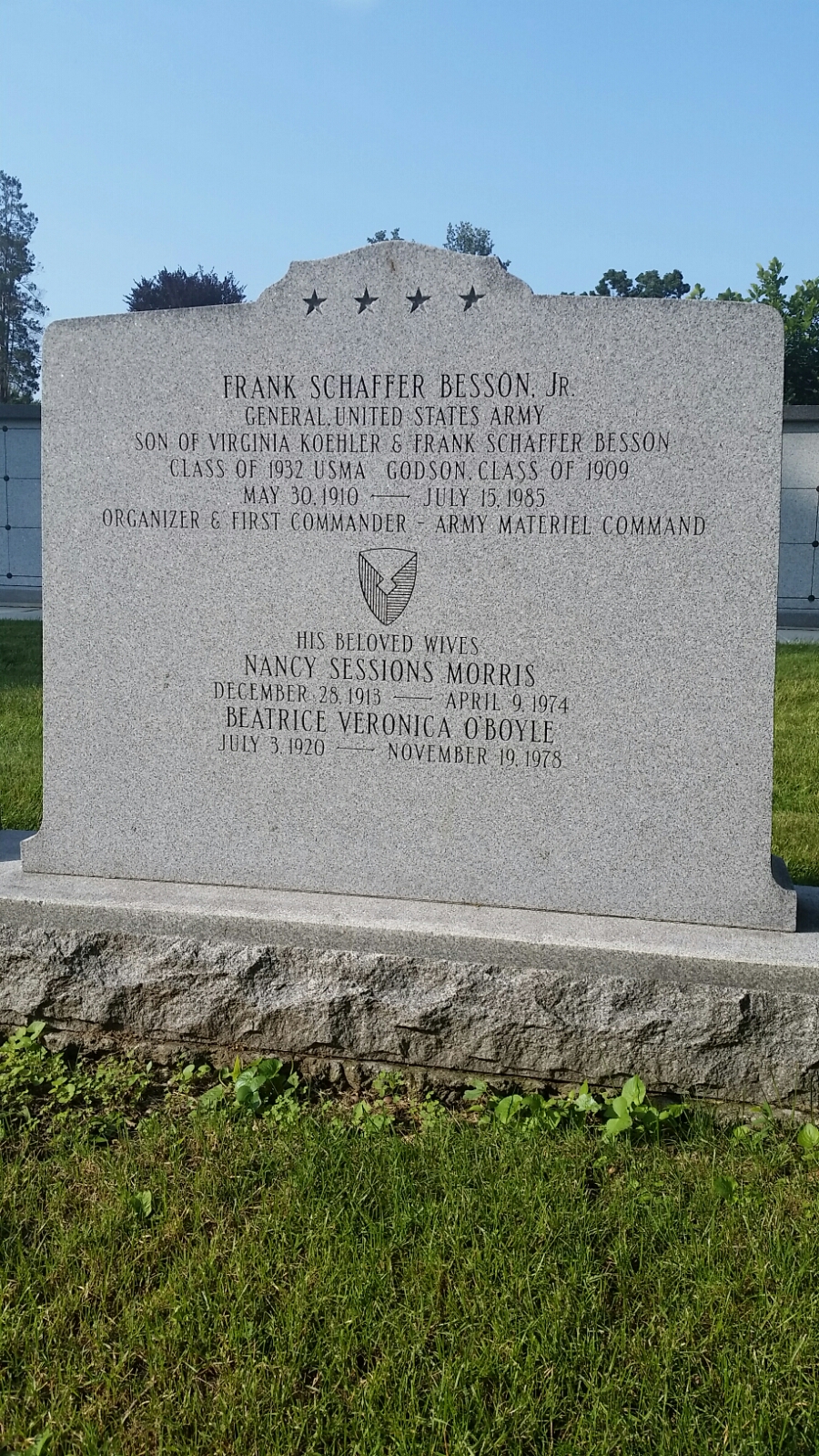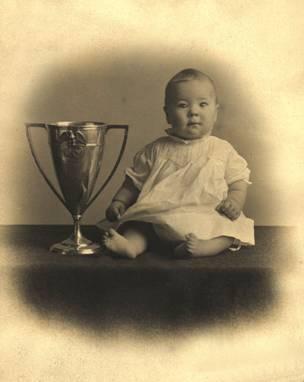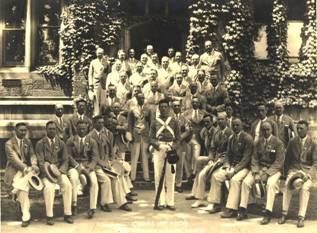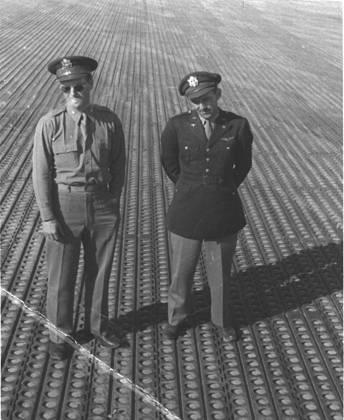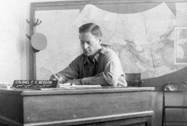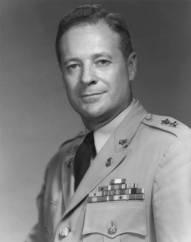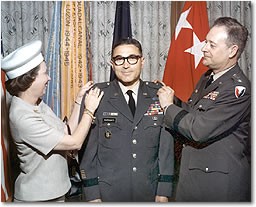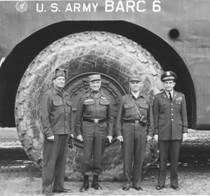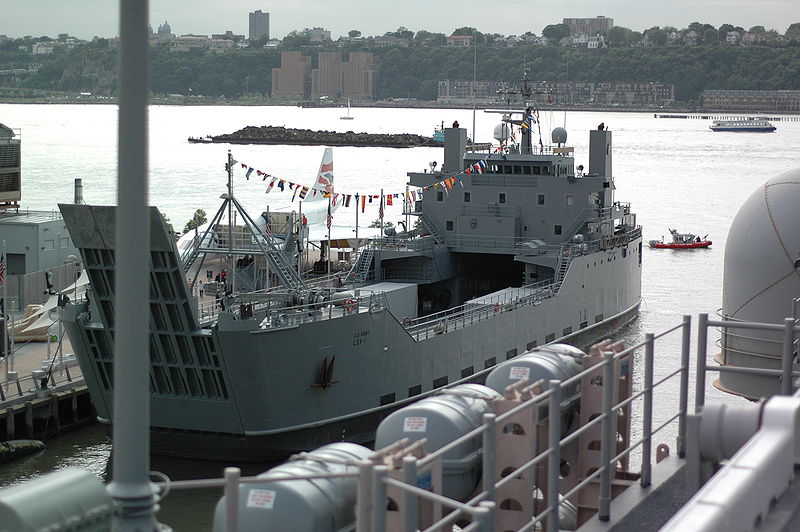Frank Schaffer Besson, Jr. was born to Frank Schaffer and Virginia Patricia (Koehler) Besson on 30 May 1910, in Detroit, Michigan. His father was a West Point graduate (class of 1909) and an officer in the U. S. Army Corps of Engineers.
Besson Jr. also attended the United States Military Academy, graduating seventh in the class of 1932. He was then commissioned as a Second Lieutenant in the U.S. Army. In 1935, he received a Master's Degree from the Massachusetts Institute of Technology. In 1940, First Lieutenant Besson was assigned to the Engineer Board at Fort Belvoir, Virginia, where he developed new equipment for the support of combat operations. He is especially known for the role he played in developing steel treadway bridges, steel landing mats for airplanes, and portable military pipelines.
Besson is credited with the studies leading to the Army's adoption of the Bailey Bridge that was used extensively in all theaters in World War II. Of that bridge, British Field Marshal Bernard Montgomery wrote in 1947: "Bailey Bridging made an immense contribution towards ending World War II. As far as my own operations were concerned, with the eighth Army in Italy and with the 21 Army Group in North West Europe, I could never have maintained the speed and tempo of forward movement without large supplies of Bailey Bridging."
Another creation of Besson's section was Pierced Steel Planking (PSP). General H.H. 'Hap' Arnold, Chief of the Army Air Corps, wanted an airfield that (1) could be built in one day, (2) handle his heaviest bombers, and (3) be easily camouflaged. The PSP they came up with was manufactured in 2 x 8 foot sheets that were hooked together and strong enough to carry the heavy bombers, yet once grass grew through the holes, the runway couldn't be easily seen from the air.
As a lieutenant colonel in 1943, Besson was assigned as Assistant Director and General Manager of the Third Military Railway Service in Iran; he assumed full command in 1944. His mission was to manage the Iranian State Railroad to get U.S. supplies to Russia. The railroad was a single track road, winding 1,000 miles from the Persian Gulf through marshlands, rugged mountains and desert to the Iranian-Russian border on the Caspian Sea.
Despite language barriers, environmental conditions and other difficulties, the railroad surpassed all previous performance records. Under his command, more than five million tons of essential war materials were delivered to the Russian Army to help repel the German attack.
Besson was awarded the Army Legion of Merit for his outstanding work, and the Shah of Iran personally presented him with the Iranian Medal, The Order of Hoymanoun, Second Class.
Besson was promoted to Brigadier General in early 1945, becoming, at age 34, the youngest BG in the ground forces of World War II. * After Victory-Europe Day on May 8, 1945, General Besson was assigned as Deputy Chief Transportation Officer of the Western Pacific, and assumed total control of the railroads in the Eighth Army's assigned zone of occupation. Incoming occupation troops were soon moving throughout northern Japan by rail from shipside to airport. During the first year of occupation, General Besson directed the rehabilitation of the Japanese rail system, moving more than 200,000 troops and 150,000 tons of supplies in the first two months.
From 1946-1948, BG Besson was assigned by General Douglas MacArthur as Director of the Civil Transportation Division, Supreme Headquarters, Allied Powers in Japan. He was responsible for all military water, motor and rail transportation activities in Japan, the Philippines, the Marianas, and Korea. Among his accomplishments was the establishment of a 'depot on wheels,' storing in 20,000 rail cars valuable military equipment released by inactivated units. Saved from deterioration and loss, this equipment was later rehabilitated and played an important part in the Korean campaign. Besson's work in the Pacific earned the praise of General MacArthur.
BG Besson returned to the U.S. in 1948 and served for nearly five years as Deputy Chief of Army Transportation.
A subsequent assignment included a tour as Assistant Chief of Staff, Supreme Headquarters Allied Powers Europe (SHAPE), where General Besson formulated logistics plans and overall programs to meet the complex requirements of the fifteen nations of the NATO alliance. His efforts in instituting a system for 'costing out' five-year programs, thereby bringing force goals into consonance with available resources, earned him the first Distinguished Service Medal to be awarded at SHAPE headquarters.
Besson was promoted to Major General in 1950, and in 1953, assumed command of the U.S. Army Transportation Center and School at Fort Eustis. He directed extensive studies to develop new doctrines that would enable the Corps to better cope with the requirements of modern warfare. His visions involved the routine, rather than the emergency, use of air transportation, employment of express surface transport, full exploitation of containerization, improved amphibious vessels, such as the 5-ton and 15-ton LARC's (Lighter, Amphibious, Resupply, Cargo) and the 60-ton BARC (Barge, Amphibious, Resupply, Cargo), material handling equipment, and ships of radical design. The maiden voyage of the BARC was at Fort Lawton, Washington in 1952. He also introduced the roll-on/roll-off technique for the rapid loading and discharge of wheeled and tracked vehicles.
General Besson was the Chief of Transportation, U.S. Army from March 1958 until April 1962. In 1962, Besson was promoted to Lieutenant General, and became the first Chief of the U.S. Army Materiel Command (AMC), formed in 1962. AMC represented a major reorganization within the Army, consolidating all seven technical services. During his command, the mammoth logistical organization, with an annual budget exceeding $14 billion and an inventory of $21 billion, employed more than 160,000 civilian personnel, in addition to its military complement of 14,000.
Many consider General Besson's role in establishing the AMC into a single command - without disrupting effective materiel support for the Army - and his six years of service as its first commander, as his most valuable contribution to the Army. His success resulted in his receiving the Merit Award of the Armed Forces Management Association in 1963.
On 27 May 1964, Frank S. Besson, Jr. became the 75th officer in the Army's 189-year history to become a four star general. He was the first Transportation Corps officer to achieve that rank and also the first to achieve the rank as head of a logistical organization in peacetime.
In March 1969, General Besson left AMC to serve as Chairman of the Joint Logistics Review Board, reporting on worldwide logistic support to U.S. forces during the Vietnam conflict. He retired in July 1970 and was promptly recalled to active duty to establish procedures to implement the Board's recommendation. Besson was able to permanently retire in October 1970 after more than 37 years of commissioned service; 25 of them as a general officer.
During his Army career, Besson received many awards and decorations from both the United States and foreign countries. His awards include:
Distinguished Service Medal (Army) with 2 Bronze Oak Leaf Clusters
Legion of Merit with Bronze Oak Leaf Cluster
The Iranian Order of Homayoun Star, Second Class
Commander of the Order of the British Empire (CBE)
The Republic of Korea's Order of the Military Merit, Second Class (Ulchi)
On 4 December 1986, at Fort Rucker, Alabama, the Army Aviation Association of America posthumously inducted General Frank Schaffer Besson, Jr. into the Army Aviation Hall of Fame. The induction honors those who have made an outstanding contribution over an extended period, or a truly exceptional achievement, and records those individuals and acts for posterity. The Army Aviation Hall of Fame honors not just flying heroes but all commissioned, warrant and non-commissioned officers and Soldiers, and civilians from government and industry who have contributed to Army aviation.
In 1970, Besson was appointed by President Nixon as a founding director, and the first CEO, of the National Rail Passenger Corporation; the operators of AMTRAK.
He was founder and member of the Board of Directors of Services National Bank of Alexandria, Virginia. Besson was also a member of the Board of Directors of the Environmental Research Corporation of Fairfax County, Virginia.
In 1980, Frank S. Besson, Jr. married Frances Howell "Betty" Wheeler, widow of General Earle Gilmore Wheeler, a former Army Chief of Staff and Chairman of the Joint Chiefs of Staff. Like Besson, Wheeler was a member of the class of 1932 at the U.S. Military Academy. Frank and Betty lived in Alexandria until his death in 1985. After General Besson's death, Betty resumed using the name of her first husband and is buried with him at Arlington National Cemetery. In 1988, Mrs. Wheeler christened the Army logistical support vessel, The "General Frank S. Besson Jr."
On 15 July 1985, at the age of 75, General Frank Schaffer Besson, Jr. died of cancer at Walter Reed Army Medical Center.
* The same claim of becoming, at age 34, the youngest brigadier general in the Army's ground forces of World War II, has been made on behalf of Gerald Joseph Higgins. He was promoted in August 1944 as Assistant Division Commander of the 101st Airborne Division. Higgins was born 29 August 1909 and allegedly promoted in August 1944; Besson was born 30 May 1910 and allegedly promoted in May 1945. Although I have had the honor of compiling bios for both men, I cannot compute which claim is valid as I do not have exact, verifiable dates of the promotion of Higgins or Besson. However, Higgins certainly held that record for at least a short time. CAL
Bio compiled by Charles A. Lewis with gratitude for the assistance of the U.S. Army Transportation Museum.
Honors
GEN Frank S. Besson, Jr. has Honoree Record 189 at MilitaryHallofHonor.com.
Frank Schaffer Besson, Jr. was born to Frank Schaffer and Virginia Patricia (Koehler) Besson on 30 May 1910, in Detroit, Michigan. His father was a West Point graduate (class of 1909) and an officer in the U. S. Army Corps of Engineers.
Besson Jr. also attended the United States Military Academy, graduating seventh in the class of 1932. He was then commissioned as a Second Lieutenant in the U.S. Army. In 1935, he received a Master's Degree from the Massachusetts Institute of Technology. In 1940, First Lieutenant Besson was assigned to the Engineer Board at Fort Belvoir, Virginia, where he developed new equipment for the support of combat operations. He is especially known for the role he played in developing steel treadway bridges, steel landing mats for airplanes, and portable military pipelines.
Besson is credited with the studies leading to the Army's adoption of the Bailey Bridge that was used extensively in all theaters in World War II. Of that bridge, British Field Marshal Bernard Montgomery wrote in 1947: "Bailey Bridging made an immense contribution towards ending World War II. As far as my own operations were concerned, with the eighth Army in Italy and with the 21 Army Group in North West Europe, I could never have maintained the speed and tempo of forward movement without large supplies of Bailey Bridging."
Another creation of Besson's section was Pierced Steel Planking (PSP). General H.H. 'Hap' Arnold, Chief of the Army Air Corps, wanted an airfield that (1) could be built in one day, (2) handle his heaviest bombers, and (3) be easily camouflaged. The PSP they came up with was manufactured in 2 x 8 foot sheets that were hooked together and strong enough to carry the heavy bombers, yet once grass grew through the holes, the runway couldn't be easily seen from the air.
As a lieutenant colonel in 1943, Besson was assigned as Assistant Director and General Manager of the Third Military Railway Service in Iran; he assumed full command in 1944. His mission was to manage the Iranian State Railroad to get U.S. supplies to Russia. The railroad was a single track road, winding 1,000 miles from the Persian Gulf through marshlands, rugged mountains and desert to the Iranian-Russian border on the Caspian Sea.
Despite language barriers, environmental conditions and other difficulties, the railroad surpassed all previous performance records. Under his command, more than five million tons of essential war materials were delivered to the Russian Army to help repel the German attack.
Besson was awarded the Army Legion of Merit for his outstanding work, and the Shah of Iran personally presented him with the Iranian Medal, The Order of Hoymanoun, Second Class.
Besson was promoted to Brigadier General in early 1945, becoming, at age 34, the youngest BG in the ground forces of World War II. * After Victory-Europe Day on May 8, 1945, General Besson was assigned as Deputy Chief Transportation Officer of the Western Pacific, and assumed total control of the railroads in the Eighth Army's assigned zone of occupation. Incoming occupation troops were soon moving throughout northern Japan by rail from shipside to airport. During the first year of occupation, General Besson directed the rehabilitation of the Japanese rail system, moving more than 200,000 troops and 150,000 tons of supplies in the first two months.
From 1946-1948, BG Besson was assigned by General Douglas MacArthur as Director of the Civil Transportation Division, Supreme Headquarters, Allied Powers in Japan. He was responsible for all military water, motor and rail transportation activities in Japan, the Philippines, the Marianas, and Korea. Among his accomplishments was the establishment of a 'depot on wheels,' storing in 20,000 rail cars valuable military equipment released by inactivated units. Saved from deterioration and loss, this equipment was later rehabilitated and played an important part in the Korean campaign. Besson's work in the Pacific earned the praise of General MacArthur.
BG Besson returned to the U.S. in 1948 and served for nearly five years as Deputy Chief of Army Transportation.
A subsequent assignment included a tour as Assistant Chief of Staff, Supreme Headquarters Allied Powers Europe (SHAPE), where General Besson formulated logistics plans and overall programs to meet the complex requirements of the fifteen nations of the NATO alliance. His efforts in instituting a system for 'costing out' five-year programs, thereby bringing force goals into consonance with available resources, earned him the first Distinguished Service Medal to be awarded at SHAPE headquarters.
Besson was promoted to Major General in 1950, and in 1953, assumed command of the U.S. Army Transportation Center and School at Fort Eustis. He directed extensive studies to develop new doctrines that would enable the Corps to better cope with the requirements of modern warfare. His visions involved the routine, rather than the emergency, use of air transportation, employment of express surface transport, full exploitation of containerization, improved amphibious vessels, such as the 5-ton and 15-ton LARC's (Lighter, Amphibious, Resupply, Cargo) and the 60-ton BARC (Barge, Amphibious, Resupply, Cargo), material handling equipment, and ships of radical design. The maiden voyage of the BARC was at Fort Lawton, Washington in 1952. He also introduced the roll-on/roll-off technique for the rapid loading and discharge of wheeled and tracked vehicles.
General Besson was the Chief of Transportation, U.S. Army from March 1958 until April 1962. In 1962, Besson was promoted to Lieutenant General, and became the first Chief of the U.S. Army Materiel Command (AMC), formed in 1962. AMC represented a major reorganization within the Army, consolidating all seven technical services. During his command, the mammoth logistical organization, with an annual budget exceeding $14 billion and an inventory of $21 billion, employed more than 160,000 civilian personnel, in addition to its military complement of 14,000.
Many consider General Besson's role in establishing the AMC into a single command - without disrupting effective materiel support for the Army - and his six years of service as its first commander, as his most valuable contribution to the Army. His success resulted in his receiving the Merit Award of the Armed Forces Management Association in 1963.
On 27 May 1964, Frank S. Besson, Jr. became the 75th officer in the Army's 189-year history to become a four star general. He was the first Transportation Corps officer to achieve that rank and also the first to achieve the rank as head of a logistical organization in peacetime.
In March 1969, General Besson left AMC to serve as Chairman of the Joint Logistics Review Board, reporting on worldwide logistic support to U.S. forces during the Vietnam conflict. He retired in July 1970 and was promptly recalled to active duty to establish procedures to implement the Board's recommendation. Besson was able to permanently retire in October 1970 after more than 37 years of commissioned service; 25 of them as a general officer.
During his Army career, Besson received many awards and decorations from both the United States and foreign countries. His awards include:
Distinguished Service Medal (Army) with 2 Bronze Oak Leaf Clusters
Legion of Merit with Bronze Oak Leaf Cluster
The Iranian Order of Homayoun Star, Second Class
Commander of the Order of the British Empire (CBE)
The Republic of Korea's Order of the Military Merit, Second Class (Ulchi)
On 4 December 1986, at Fort Rucker, Alabama, the Army Aviation Association of America posthumously inducted General Frank Schaffer Besson, Jr. into the Army Aviation Hall of Fame. The induction honors those who have made an outstanding contribution over an extended period, or a truly exceptional achievement, and records those individuals and acts for posterity. The Army Aviation Hall of Fame honors not just flying heroes but all commissioned, warrant and non-commissioned officers and Soldiers, and civilians from government and industry who have contributed to Army aviation.
In 1970, Besson was appointed by President Nixon as a founding director, and the first CEO, of the National Rail Passenger Corporation; the operators of AMTRAK.
He was founder and member of the Board of Directors of Services National Bank of Alexandria, Virginia. Besson was also a member of the Board of Directors of the Environmental Research Corporation of Fairfax County, Virginia.
In 1980, Frank S. Besson, Jr. married Frances Howell "Betty" Wheeler, widow of General Earle Gilmore Wheeler, a former Army Chief of Staff and Chairman of the Joint Chiefs of Staff. Like Besson, Wheeler was a member of the class of 1932 at the U.S. Military Academy. Frank and Betty lived in Alexandria until his death in 1985. After General Besson's death, Betty resumed using the name of her first husband and is buried with him at Arlington National Cemetery. In 1988, Mrs. Wheeler christened the Army logistical support vessel, The "General Frank S. Besson Jr."
On 15 July 1985, at the age of 75, General Frank Schaffer Besson, Jr. died of cancer at Walter Reed Army Medical Center.
* The same claim of becoming, at age 34, the youngest brigadier general in the Army's ground forces of World War II, has been made on behalf of Gerald Joseph Higgins. He was promoted in August 1944 as Assistant Division Commander of the 101st Airborne Division. Higgins was born 29 August 1909 and allegedly promoted in August 1944; Besson was born 30 May 1910 and allegedly promoted in May 1945. Although I have had the honor of compiling bios for both men, I cannot compute which claim is valid as I do not have exact, verifiable dates of the promotion of Higgins or Besson. However, Higgins certainly held that record for at least a short time. CAL
Bio compiled by Charles A. Lewis with gratitude for the assistance of the U.S. Army Transportation Museum.
Honors
GEN Frank S. Besson, Jr. has Honoree Record 189 at MilitaryHallofHonor.com.
